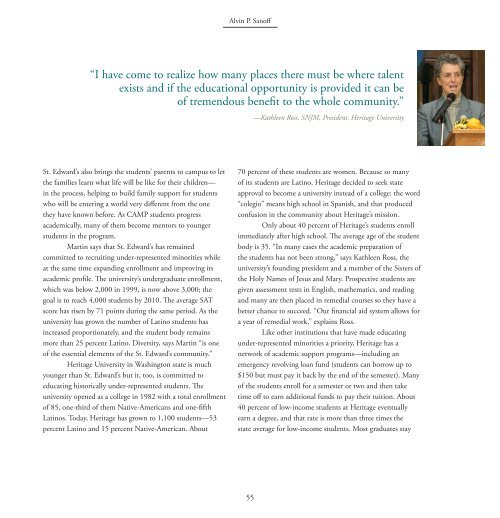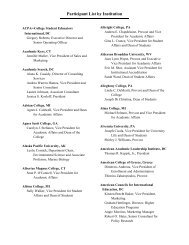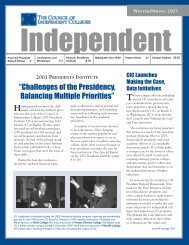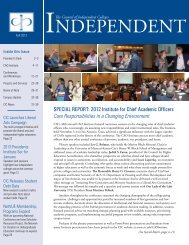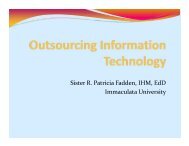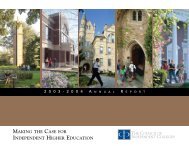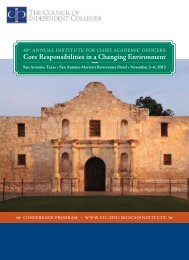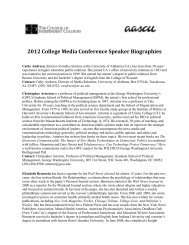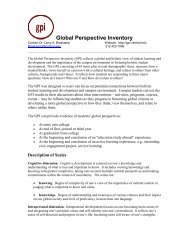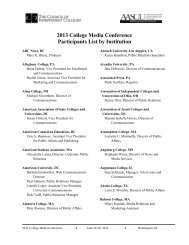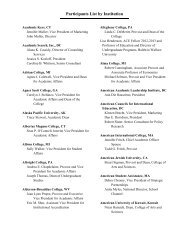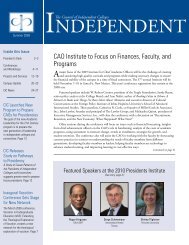Meeting the Challenge: - The Council of Independent Colleges
Meeting the Challenge: - The Council of Independent Colleges
Meeting the Challenge: - The Council of Independent Colleges
You also want an ePaper? Increase the reach of your titles
YUMPU automatically turns print PDFs into web optimized ePapers that Google loves.
Alvin P. San<strong>of</strong>f<br />
“I have come to realize how many places <strong>the</strong>re must be where talent<br />
exists and if <strong>the</strong> educational opportunity is provided it can be<br />
<strong>of</strong> tremendous benefit to <strong>the</strong> whole community.”<br />
—Kathleen Ross, SNJM, President, Heritage University<br />
St. Edward’s also brings <strong>the</strong> students’ parents to campus to let<br />
<strong>the</strong> families learn what life will be like for <strong>the</strong>ir children—<br />
in <strong>the</strong> process, helping to build family support for students<br />
who will be entering a world very different from <strong>the</strong> one<br />
<strong>the</strong>y have known before. As CAMP students progress<br />
academically, many <strong>of</strong> <strong>the</strong>m become mentors to younger<br />
students in <strong>the</strong> program.<br />
Martin says that St. Edward’s has remained<br />
committed to recruiting under-represented minorities while<br />
at <strong>the</strong> same time expanding enrollment and improving its<br />
academic pr<strong>of</strong>ile. <strong>The</strong> university’s undergraduate enrollment,<br />
which was below 2,000 in 1999, is now above 3,000; <strong>the</strong><br />
goal is to reach 4,000 students by 2010. <strong>The</strong> average SAT<br />
score has risen by 71 points during <strong>the</strong> same period. As <strong>the</strong><br />
university has grown <strong>the</strong> number <strong>of</strong> Latino students has<br />
increased proportionately, and <strong>the</strong> student body remains<br />
more than 25 percent Latino. Diversity, says Martin “is one<br />
<strong>of</strong> <strong>the</strong> essential elements <strong>of</strong> <strong>the</strong> St. Edward’s community.”<br />
Heritage University in Washington state is much<br />
younger than St. Edward’s but it, too, is committed to<br />
educating historically under-represented students. <strong>The</strong><br />
university opened as a college in 1982 with a total enrollment<br />
<strong>of</strong> 85, one-third <strong>of</strong> <strong>the</strong>m Native-Americans and one-fifth<br />
Latinos. Today, Heritage has grown to 1,100 students—53<br />
percent Latino and 15 percent Native-American. About<br />
70 percent <strong>of</strong> <strong>the</strong>se students are women. Because so many<br />
<strong>of</strong> its students are Latino, Heritage decided to seek state<br />
approval to become a university instead <strong>of</strong> a college: <strong>the</strong> word<br />
“colegio” means high school in Spanish, and that produced<br />
confusion in <strong>the</strong> community about Heritage’s mission.<br />
Only about 40 percent <strong>of</strong> Heritage’s students enroll<br />
immediately after high school. <strong>The</strong> average age <strong>of</strong> <strong>the</strong> student<br />
body is 35. “In many cases <strong>the</strong> academic preparation <strong>of</strong><br />
<strong>the</strong> students has not been strong,” says Kathleen Ross, <strong>the</strong><br />
university’s founding president and a member <strong>of</strong> <strong>the</strong> Sisters <strong>of</strong><br />
<strong>the</strong> Holy Names <strong>of</strong> Jesus and Mary. Prospective students are<br />
given assessment tests in English, ma<strong>the</strong>matics, and reading<br />
and many are <strong>the</strong>n placed in remedial courses so <strong>the</strong>y have a<br />
better chance to succeed. “Our financial aid system allows for<br />
a year <strong>of</strong> remedial work,” explains Ross.<br />
Like o<strong>the</strong>r institutions that have made educating<br />
under-represented minorities a priority, Heritage has a<br />
network <strong>of</strong> academic support programs—including an<br />
emergency revolving loan fund (students can borrow up to<br />
$150 but must pay it back by <strong>the</strong> end <strong>of</strong> <strong>the</strong> semester). Many<br />
<strong>of</strong> <strong>the</strong> students enroll for a semester or two and <strong>the</strong>n take<br />
time <strong>of</strong>f to earn additional funds to pay <strong>the</strong>ir tuition. About<br />
40 percent <strong>of</strong> low-income students at Heritage eventually<br />
earn a degree, and that rate is more than three times <strong>the</strong><br />
state average for low-income students. Most graduates stay<br />
55


